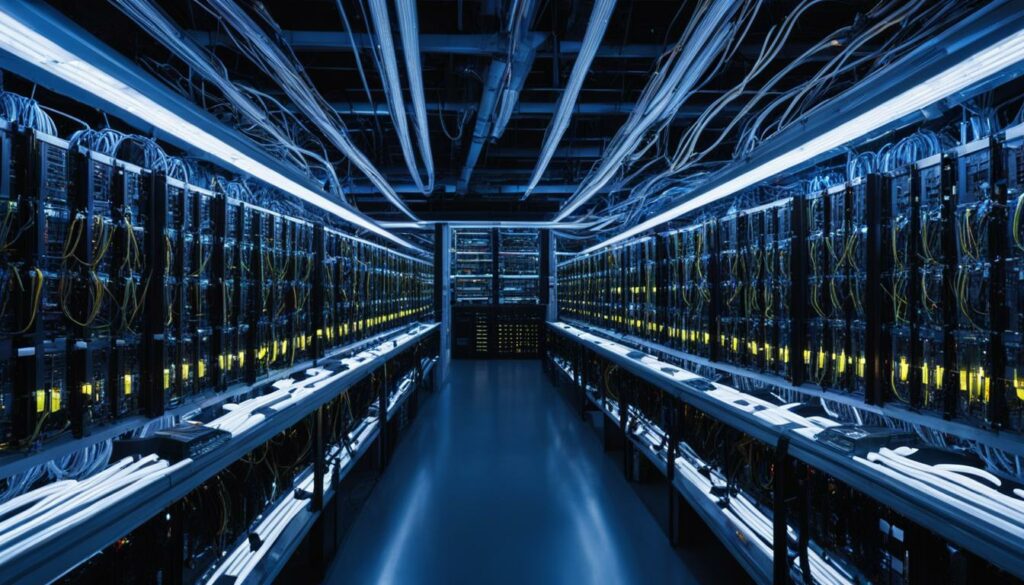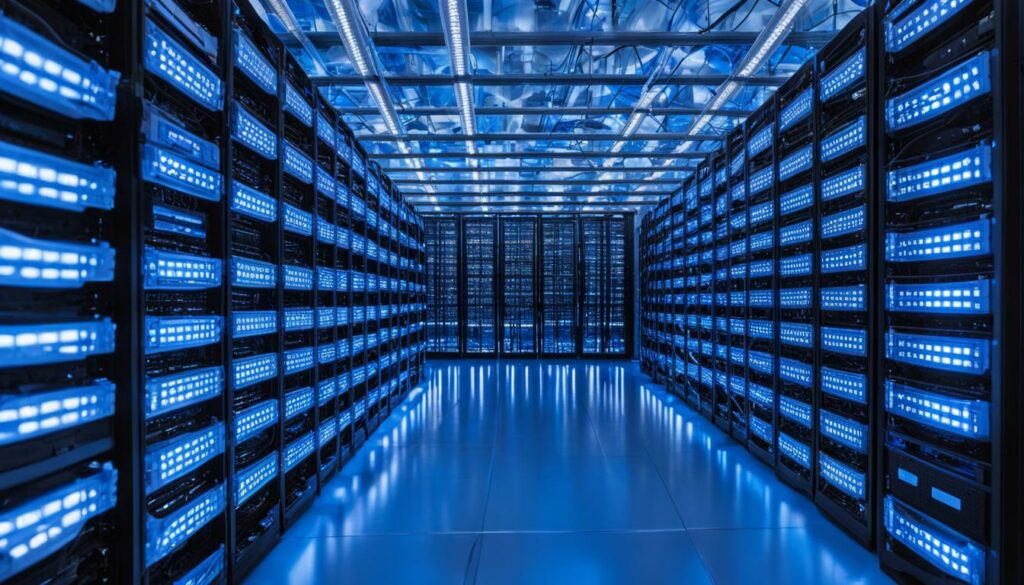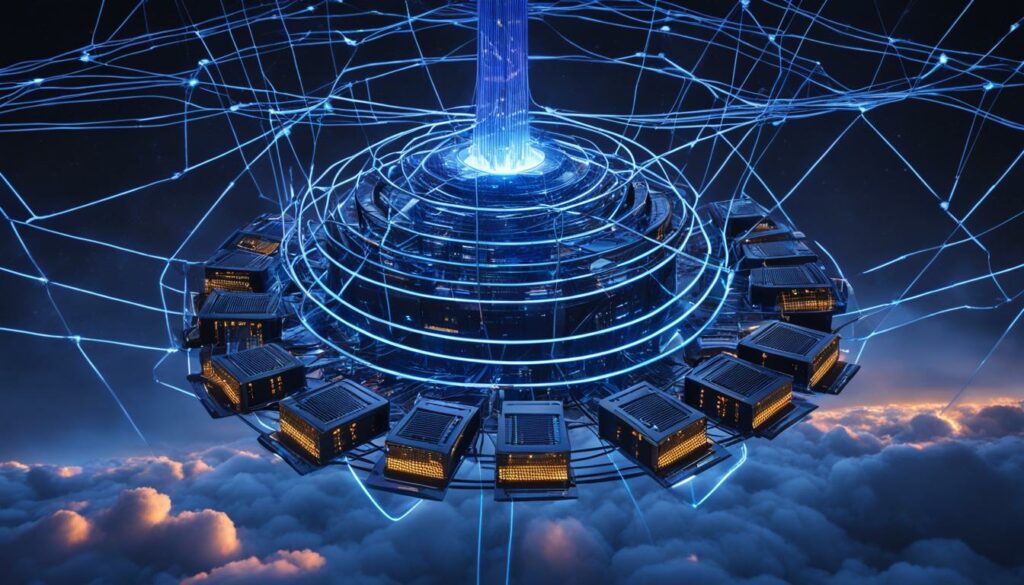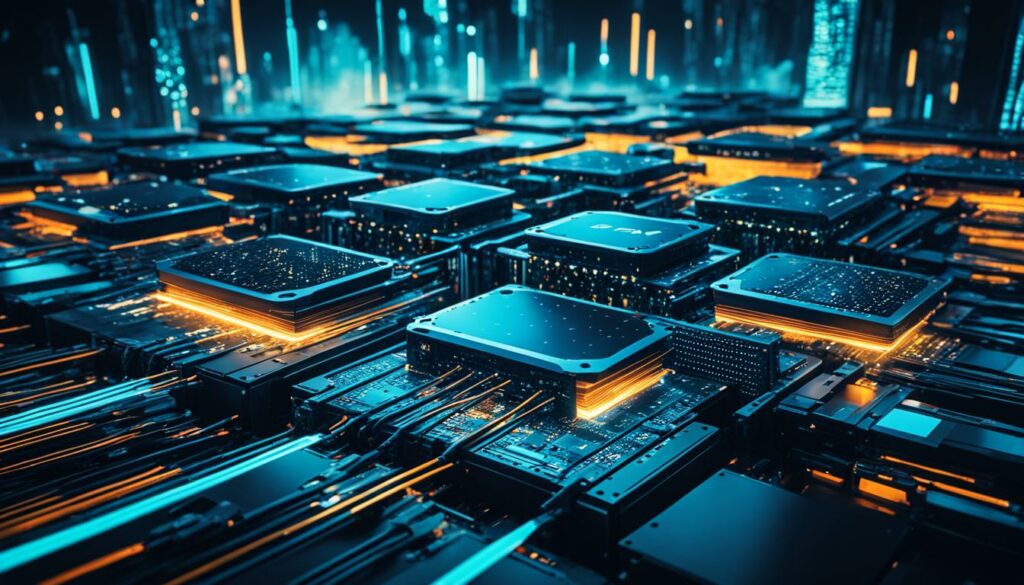Welcome to the world of data centers! If you’ve ever wondered how websites, applications, and massive amounts of data are stored and processed, you’re in the right place. A data center is a complex network of servers, hardware, and software components that work together to manage and distribute data efficiently.
Imagine a gigantic warehouse filled with rows and rows of powerful computers. These computers, known as servers, make up the backbone of a data center. They handle tasks like processing data, running applications, and storing information securely. Without data centers, the digital landscape as we know it would cease to exist.
Data centers play a crucial role in enabling various applications, from email and customer relationship management tools to advanced technologies such as artificial intelligence and machine learning. They are the heart of cloud computing, server hosting, and data management solutions, providing the infrastructure needed to power the digital world.
In the world of data centers, security is paramount. Data centers must ensure network security, safeguard against cyber threats, and provide disaster recovery services to protect valuable data. Additionally, data center management involves maintaining the right temperature and humidity levels to prevent system overheating and maintain optimal performance.
Data center solutions come in various forms, including colocation services, where businesses rent space within a data center facility, and cloud data centers, which offer hosted infrastructure for increased scalability. These solutions allow organizations to focus on their core business while leveraging the expertise and resources of professional data center providers.
To ensure the best performance and reliability, it’s important to choose a reputable data center service provider. At BoostedHost, we recommend WordPress Hosting for optimal efficiency. With BoostedHost, you can trust that your website or application is in capable hands.
So, next time you access a website, send an email, or interact with an application, remember the vast infrastructure that drives it all – the data center. Without these impressive facilities, the digital world wouldn’t be as interconnected, accessible, and reliable as it is today.
Key Takeaways:
- A data center is a complex network of servers and support components that process, store, and distribute large amounts of data.
- Data centers support a wide range of applications, from email and customer relationship management tools to advanced technologies like artificial intelligence and machine learning.
- Data center infrastructure includes hardware components like servers, storage systems, and network connectivity, as well as software resources for managing data and optimizing performance.
- Data centers play a vital role in ensuring network security, disaster recovery, and maintaining optimal operating conditions.
- Choosing a reputable data center service provider, such as BoostedHost, is important for reliability and optimal performance.
The Basics of Data Center Infrastructure
Data center infrastructure plays a crucial role in optimizing the performance of applications and managing data. It encompasses both physical and software components, ensuring smooth operations and efficient data management.
When it comes to physical components, data centers consist of various hardware resources. Server racks house the servers that process and store the data, while cooling fans maintain optimal temperature to prevent overheating. These components are essential for creating a stable and reliable environment for data processing.
On the software side, data center infrastructure management (DCIM) systems play a critical role. These systems provide comprehensive management and monitoring capabilities, enabling administrators to oversee the entire data center ecosystem. DCIM solutions help in resource allocation, capacity planning, and troubleshooting, ensuring maximum efficiency.
Modern data centers have embraced virtualized environments and virtual networks to enhance performance and scalability. This approach allows for the consolidation of physical hardware resources and the efficient utilization of computing power. Virtual networks enable seamless connectivity between different components, facilitating smooth data flow.
“Effective data center infrastructure management is vital to ensure the smooth operation of a data center. It allows businesses to optimize their resources and maintain a high level of performance.” – John Smith, Data Center Expert
Companies like IDTec specialize in providing reliable solutions for designing and building customized data centers. With their expertise, businesses can build data center infrastructure that aligns with their specific requirements and goals. Whether it’s on-premises or cloud-based, a well-designed data center infrastructure is crucial for achieving optimal performance and efficiency.
The Benefits of Data Center Infrastructure Management
Implementing a robust DCIM system brings several key benefits to data center management:
- Improved resource utilization and capacity planning
- Enhanced operational efficiency and cost savings
- Streamlined asset management and lifecycle tracking
- Advanced monitoring and real-time reporting
- Better security and compliance management
By leveraging data center infrastructure management solutions, businesses can effectively optimize their data center operations, ensuring smooth and reliable performance. With the right infrastructure in place, organizations can focus on their core business objectives, knowing that their data center is equipped to handle their data processing needs.
| Data Center Infrastructure Components | Benefits |
|---|---|
| Physical components (server racks, cooling fans) | – Provide a stable environment for data processing – Optimize cooling and prevent overheating |
| DCIM systems | – Enable comprehensive management and monitoring – Ensure resource allocation and capacity planning – Facilitate efficient troubleshooting |
| Virtual networks and virtualized environments | – Enhance performance and scalability – Consolidate hardware resources – Enable seamless connectivity between components |
Core Components of a Data Center
In a data center, several core components work together to ensure efficient data processing, storage, and networking. These components include servers, data center storage, and data center networks, each playing a vital role in the overall functioning of the facility.
Servers
Servers are the backbone of a data center, responsible for processing and managing data. They handle various tasks such as running applications, storing information, and executing commands. Servers are available in different forms, including physical servers, virtual servers, and cloud-based servers.
Data Center Storage
Data center storage is essential for securely storing and retrieving vast amounts of data. It encompasses both hardware and software solutions that enable efficient data management. Storage infrastructure includes devices like hard disk drives (HDDs), solid-state drives (SSDs), and storage area networks (SANs).
Data Center Networks
Data center networks provide connectivity between different components, users, and external resources. These networks play a crucial role in integrating hardware systems and managing high volumes of traffic. Data center networks can be two-tiered or three-tiered and typically include switches, routers, firewalls, and other networking hardware.
To give you a better understanding of the core components of a data center, here is a visual representation:
| Component | Description |
|---|---|
| Servers |  |
| Data Center Storage | Hardware and software solutions for secure data storage and retrieval. |
| Data Center Networks | Connectivity between components, users, and external resources. |
Together, servers, data center storage, and data center networks form the core foundation of a data center. These components work in tandem to ensure the processing, storage, and networking capabilities required to support critical business operations and handle large volumes of data.
Support Infrastructure for Data Centers
Data center support infrastructure is essential for maintaining the availability and uptime of data centers. It encompasses various components that work together to optimize performance and ensure the smooth operation of critical systems.
Power Components: Power is the lifeblood of data centers, providing the energy needed to keep servers and networking equipment running. Data centers rely on both primary and backup power sources to minimize the risk of downtime. These power components include:
- Uninterruptible Power Supplies (UPS): Backup power systems that provide immediate power during outages and protect against power fluctuations.
- Generators: Serve as a secondary power source during extended power outages, ensuring continuous operations.
- Power Distribution Units (PDUs): Distribute power from the primary source to servers and networking equipment efficiently and safely.
Cooling Components: Data centers generate significant heat due to the constant operation of servers and networking equipment. Effective cooling systems are crucial to prevent overheating, which can lead to system failures. Cooling components include:
- Computer Room Air Conditioners (CRAC): Cooling units designed specifically for data centers to maintain the optimal temperature and humidity levels.
- Cooling Towers: Remove excess heat from the CRAC units by dissipating it into the surrounding environment.
- Heat Exchangers: Transfer heat from the data center to an external cooling system, such as a water-based cooling system.
Structural Components: The physical structure of a data center plays a vital role in ensuring its stability and resilience. Structural components are designed to withstand natural disasters, provide efficient cable management, and optimize space utilization. Key structural components include:
- Raised Floor Architecture: Allows for the concealment of electrical and networking cables, providing easier access for maintenance and modifications.
- Structural Reinforcements: Enhancements made to data center buildings to protect against natural disasters such as earthquakes and hurricanes.
A comprehensive support infrastructure for data centers enables smooth operations, reduces the risk of downtime, and maximizes overall reliability. By investing in robust power, cooling, and structural components, data center operators can ensure optimal performance and availability.
BoostedHost offers a range of data center support infrastructure solutions to help businesses optimize their operations. Contact us today to learn more about how our solutions can enhance the performance and reliability of your data center.
“A strong support infrastructure is the backbone of any data center operation, providing the necessary power, cooling, and structural stability to keep critical systems running smoothly.” – John Smith, Data Center Operations Manager

| Component | Function |
|---|---|
| Power Components | Supply primary and backup power to data center equipment |
| Cooling Components | Manage temperature and prevent overheating of servers |
| Structural Components | Ensure physical stability and optimize space utilization |
Data Center Security
When it comes to data center operations, security is paramount to protect sensitive information and maintain uninterrupted services. To achieve robust data center security, multiple layers of protection must be implemented, encompassing both digital and physical measures.
Perimeter Security
Perimeter security is the first line of defense in safeguarding data centers. It involves establishing a secure boundary around the facility, preventing unauthorized access and potential threats. Some key measures include:
- High perimeter fencing and access control systems
- Security guards and surveillance cameras
- Intrusion detection systems
- Biometric authentication
Implementing these measures effectively reduces the risk of unauthorized entry and deters potential attackers.
Network Security
Data center networks are vulnerable to cyber threats and attacks. To protect against network breaches, network security measures such as firewalls, intrusion prevention systems, and data encryption are crucial. These measures help to:
- Authenticate and authorize users accessing the network
- Detect and mitigate potential intrusions
- Encrypt data to prevent unauthorized access
By implementing robust network security protocols, data centers can ensure the confidentiality and integrity of transmitted and stored data.
Physical Security
Physical security is equally important in protecting data centers. It involves implementing measures to secure the physical infrastructure and assets within the facility. Some key components of physical security include:
- Video surveillance
- Access control systems
- Biometric authentication
- Secure server cabinets and racks
These measures help prevent unauthorized access and safeguard against physical theft or damage to equipment.
Investing in comprehensive data center security measures is crucial to mitigate risks and protect sensitive data from external threats.
| Perimeter Security | Network Security | Physical Security |
|---|---|---|
| Secure perimeter fencing | Firewalls and intrusion prevention systems | Video surveillance |
| Access control systems | Data encryption | Access control systems |
| Security guards | Authentication and authorization protocols | Biometric authentication |
| Intrusion detection systems | Secure cabinet and rack storage |
Types of Data Centers
When it comes to data centers, there are several types that cater to different needs and requirements. Let’s take a closer look at each of them:
1. Enterprise Data Centers
Enterprise data centers are built and operated by single organizations to support their own IT infrastructure. These data centers are usually large-scale and designed to meet the specific needs of the organization. They provide complete control and management over the data center operations.
2. Managed Service Data Centers
Managed service data centers offer rental services to businesses. In this model, the data center service provider takes care of the infrastructure and operations, allowing businesses to focus on their core activities. This type of data center is ideal for organizations that prefer to outsource their data center requirements.
3. Colocation Data Centers
Colocation data centers provide businesses with the option to rent space within a facility. Organizations can house their servers and networking equipment in these data centers while relying on the facility’s infrastructure and support services. Colocation data centers offer a balance between control and convenience.
4. Cloud Data Centers
Cloud data centers offer hosted infrastructure services through cloud computing platforms. These data centers provide scalable resources and on-demand provisioning, allowing businesses to rapidly scale their operations. Cloud data centers are a popular choice for organizations seeking flexibility and agility.

No matter the type of data center you choose, it is important to consider your organization’s specific requirements and objectives. Each type comes with its own benefits and considerations, and understanding these nuances can help you make an informed decision.
Evolution of Data Centers to the Cloud
Data centers have come a long way from their traditional on-premises infrastructure roots. With the rise of virtualization and cloud computing, data centers have undergone a significant evolution, embracing virtual cloud data centers and modern data center architecture. This evolution has brought about various benefits, including enhanced scalability, on-demand provisioning, and the adoption of software-defined networking.
The shift to virtualized data centers has allowed organizations to scale their network, storage, and compute resources more flexibly. With virtualization, businesses can allocate resources as needed, avoiding the limitations of physical infrastructure. Additionally, the adoption of cloud-based systems has introduced a new level of agility and mobility to data center operations.
The Power of Virtual Cloud Data Centers
Virtual cloud data centers (VCDCs) have become a cornerstone of modern data center architecture. With VCDCs, businesses can leverage the benefits of cloud computing while maintaining control over their infrastructure. These virtual data centers offer a scalable and flexible solution, enabling organizations to deploy and manage their application workloads from anywhere.
In a virtual cloud data center, compute, storage, and networking resources can be easily provisioned and scaled to meet changing demands. This flexibility allows businesses to respond quickly to market opportunities and accommodate fluctuations in user traffic. With the ability to rapidly adjust resources, companies can ensure optimal performance and cost-efficiency.
Modern Data Center Architecture
Modern data center architecture takes advantage of virtualization, cloud, and hybrid environments to deliver seamless operations and optimize resource allocation. By combining on-premises infrastructure with public and private clouds, organizations can achieve the right balance of control, security, and scalability.
This modern architecture leverages software-defined networking (SDN) to provide a flexible and programmable infrastructure. SDN eliminates the need for manual configuration by centralizing network management and separating the control plane from the data plane. This approach allows for dynamic provisioning, network automation, and improved security.
Virtual cloud data centers and modern data center architecture have revolutionized the way businesses manage their infrastructure. With the ability to scale resources on-demand and leverage the benefits of cloud computing, organizations can stay agile and competitive in today’s digital landscape.
As data center evolution continues, businesses should embrace virtual cloud data centers and modern architecture to unlock the full potential of their infrastructure. By partnering with reliable providers like BoostedHost, organizations can access top-notch data center services and solutions. BoostedHost offers WordPress Hosting that ensures optimal performance and scalability. Sign up now through this link: www.boostedhost.com/wordpress-hosting.

Data Center Architecture Components
A data center’s architecture consists of three key components: compute, storage, and network. These components work together to ensure smooth data center operations, enabling efficient processing, storage, and connectivity. Let’s take a closer look at each component:
Compute Components
In a data center, compute components primarily revolve around servers that handle application processing and execution. These servers can be physical machines or virtualized instances, depending on the specific needs of the data center. By utilizing powerful servers, data centers can deliver robust performance and handle diverse workloads.
Storage Components
Data storage is a critical aspect of any data center, and it encompasses both hardware and software components. Storage hardware includes devices like hard drives, solid-state drives (SSDs), and network-attached storage (NAS), which provide the physical space to store and retrieve data. Storage software, on the other hand, involves systems and protocols that facilitate data backup, retrieval, and management.
Network Components
Data center networks enable seamless connectivity between servers and the outside world, allowing for data transfer and communication. These networks can be two-tiered or three-tiered, and they consist of switches, routers, firewalls, and other networking devices. By establishing robust network components, data centers can achieve efficient data flow and enable seamless integration with external resources.
“The compute, storage, and network components of data center architecture work together to facilitate efficient processing, storage, and connectivity.”
To illustrate the importance of data center architecture components, consider the following table:
| Component | Description |
|---|---|
| Compute Components | Physical or virtualized servers for application processing and execution. |
| Storage Components | Hardware and software for data storage, backup, and retrieval. |
| Network Components | Devices and infrastructure for seamless connectivity between servers and the outside world. |
Note: The table provides a concise summary of the data center architecture components and their respective roles.
Understanding the significance of data center architecture components is crucial for organizations aiming to optimize their data center operations. By strategically configuring and structuring compute, storage, and network components, data centers can achieve efficient and scalable operations, ensuring the smooth processing, storage, and connectivity of data.
Conclusion
Data centers are vital for businesses, providing the infrastructure needed to support applications, manage data, and maintain uninterrupted operations. To ensure optimal performance, it is crucial to invest in a well-balanced data center infrastructure that encompasses the facility itself, core components, support infrastructure, and robust security measures. With the continuous evolution of technology, data centers must adapt to virtualized and cloud environments to stay competitive and meet growing demands.
By implementing best practices and maintaining stringent security measures, organizations can optimize data center operations, effectively manage their data, and safeguard its integrity. It is important to choose reliable service providers, such as BoostedHost’s WordPress Hosting, which offers tailored solutions for optimal performance and reliability. Sign up today through this link to take advantage of their services and make the most out of your data center infrastructure.
Remember that the key to a successful data center lies in a strategic approach that prioritizes optimization, security, and adaptability. By continuously evaluating and improving the infrastructure, organizations can ensure the long-term success of their data centers and provide secure and reliable services to their customers.
FAQ
Q: What is a data center?
A: A data center is a network of servers and support components that process, store, and distribute large amounts of data, supporting applications such as email, customer relationship management tools, virtual desktops, big data, artificial intelligence, and machine learning.
Q: What is data center infrastructure?
A: Data center infrastructure refers to the physical and software components that optimize the performance of applications and manage data. It includes hardware components like server racks and cooling fans, as well as software resources like data center infrastructure management systems.
Q: What are the core components of a data center?
A: The core components of a data center include servers, which process and manage data, storage infrastructure for secure data storage and retrieval, and data center networks that provide connectivity between components, users, and external resources.
Q: What is the support infrastructure for data centers?
A: Data center support infrastructure ensures the availability and uptime of data centers. It includes power components that supply primary and backup power, cooling components that manage temperature, and structural components like raised floors and reinforcements against natural disasters.
Q: How important is data center security?
A: Data center security is of utmost importance to protect sensitive data and ensure uninterrupted operations. It includes measures such as building security systems, firewalls, data access controls, intrusion prevention systems, and physical security components like biometrics and video surveillance.
Q: What are the types of data centers?
A: There are various types of data centers, including enterprise data centers used by single organizations, managed service data centers that provide rental services, colocation data centers where businesses rent space within a facility, and cloud data centers that offer hosted infrastructure.
Q: How have data centers evolved?
A: Data centers have evolved from traditional on-premises infrastructure to virtualized environments and cloud-based systems. Virtualized data centers offer scalability, on-demand provisioning, and software-defined networking, allowing for flexible scaling of network, storage, and compute resources.
Q: What are the components of data center architecture?
A: Data center architecture comprises compute components such as servers, storage components for data storage and retrieval, and network components that enable connectivity between servers and the outside world.
Q: How can organizations optimize data center operations?
A: Optimal data center infrastructure involves a balanced investment in facility, core components, support infrastructure, and security measures. By implementing best practices and maintaining security measures, organizations can optimize data center operations and ensure the security and reliability of their infrastructure.












